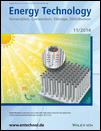Inside Cover: One-Dimensional, Additive-Free, Single-Crystal TiO2 Nanostructured Anodes Synthesized by a Single-Step Aerosol Process for High-Rate Lithium-Ion Batteries (Energy Technol. 11/2014)
Graphical Abstract
Driving Battery Development with Nanostructures: The cover picture shows the synthesis of highly oriented, single-crystalline TiO2 nano-columns directly on the current collector by using an aerosol chemical vapor deposition (ACVD) process. As described in the Full Paper on page 906 from Pratim Biswas and colleagues at Washington University in St. Louis and Indian Insitute of Technology, Bombay, the nanostructures exhibit excellent electrochemical performance and rate capability even without the presence of any binding agents or conductive additives. This makes them extremely suitable for high-rate lithium-ion battery anodes such as in electric vehicles and hybrid electric vehicles.





